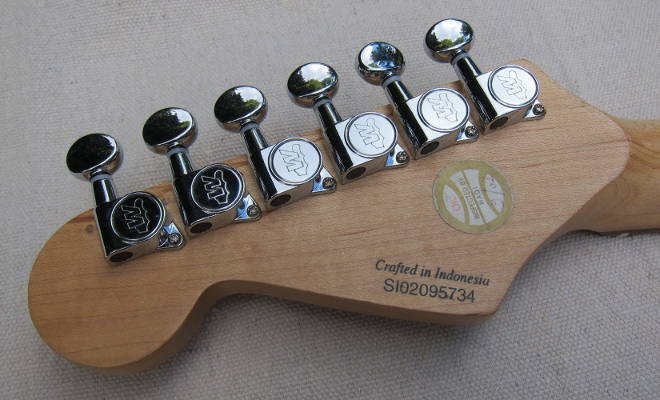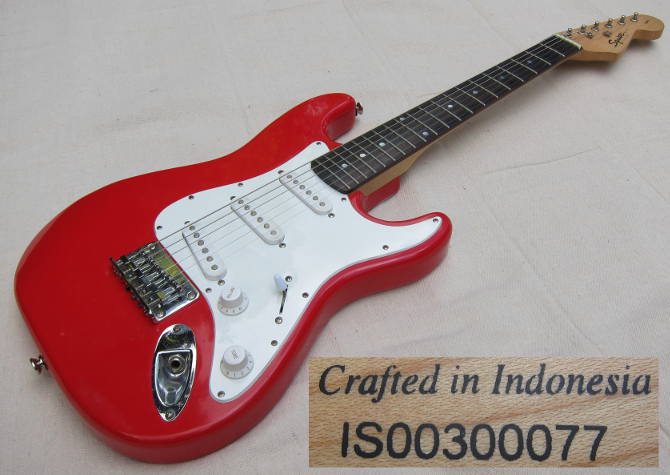Fender Squier Serial Number Indonesia
Posted By admin On 28/04/19- Indonesia Fender Squier Serial Number
- Fender Squier Serial Numbers Indonesia
- Fender Guitar Made In Indonesia
IC: I = Indonesia, C = Cor-Tek (Cort), the serial number prefix is followed by a 2 number year. IS: I = Indonesia, S = Samick, the serial number prefix is followed by a 2 number year. For example 'IC02' Made in 2002. In 2009-10 some Indonesian Squier's had the prefix ICS09XXXXX and ICS10XXXXX.
There are a number of standard models that have the ICS prefix some are FSR but some are just normal run models. It therefore appears as though the the S in ICS is only an indication as to whether it is a Factory Special Run or FSR guitar (manufactured by Cor-Tek in Indonesia). It also appears likely that any FSR guitar beginning with ICS will be a Squier 'Standard' as opposed to any of the other models i.e. CV, Deluxe etc. In your case though it is a Vintage Modified model.
I'd say it is a Cort made one. I've also seen some serials starting 'I' that were made in India. But ICS is usually Indonesia. The '10' means 2010 model year. Hope that helps.
Crack, serial number, keygen, free software, key generator. Alexa Rank: #38,823 Google PR: 5 of 10 Daily Visits: 10,301 Website Value: $74,167 USD. Video by Topic - Fender Squier Strat Indonesia Serial Number. Weird serial no. On Squier Bass. Number tracing page was that some 2009's and 2010's have the ICS serial number, I=Indonesia C=Cor. Mine says PN.

IC: I = Indonesia, C = Cor-Tek (Cort), the serial number prefix is followed by a 2 number year. IS: I = Indonesia, S = Samick, the serial number prefix is followed by a 2 number year. For example 'IC02' Made in 2002. In 2009-10 some Indonesian Squier's had the prefix ICS09XXXXX and ICS10XXXXX. There are a number of standard models that have the ICS prefix some are FSR but some are just normal run models.
It therefore appears as though the the S in ICS is only an indication as to whether it is a Factory Special Run or FSR guitar (manufactured by Cor-Tek in Indonesia). It also appears likely that any FSR guitar beginning with ICS will be a Squier 'Standard' as opposed to any of the other models i.e. CV, Deluxe etc. In your case though it is a Vintage Modified model. I'd say it is a Cort made one.
I've also seen some serials starting 'I' that were made in India. But ICS is usually Indonesia. The '10' means 2010 model year. Hope that helps. Follow-up question: I understand it's supposed to be ICxx + 6 digits, but what does it mean if it's ICxx + 7 digits? It looks like it could be IC + YYMMDD + xxx (or possibly IC + YYDDMM + xxx)? I honestly don't know about the extra digit other than to set apart instruments for FMIC distribution from those going to international distributors.
The reason they need to do this is because FMIC and the international Fender/Squier distributors have different warranties and totally separate support systems including service centers. FMIC ships the instrument to the international distributor and they are done with it.
Whenever there is a serial irregularity on a FMIC instrument quite often that is the reason why. This is a practice that actually goes back to Fender's early days.
The oddball serial locks the international instruments out of FMIC North American support. All the online serial guides, dater software sites etc base all their data exclusively on the FMIC distributed serials. Therefore it is entirely possible to have a genuine Fender '76 Jazz Bass with a serial that doesn't fit any published format on any website and in cases like that it is because it was shipped from the factory to an international distributor. They are genuine, but the serial won't 'compute' or match exactly with any online data. Is there a consensus on the Squier made-in-Indonesia P-basses? As compared to the Squier Affinity made-in-China basses? I wouldn't say a consensus but more of a general understanding that the Affinity is an entry line with woods, hardware, electronics etc that is not quite as good as the more expensive models.
The Standards will be better and any Deluxe or Artist Series instrument can be better still. That being said it is entirely possible to get an Affinity that is a totally usable instrument. You may have to demo 10 to find one you really like, but even an Affinity is better than no P-Bass at all. The fact is a higher end Chinese bass can whoop up pretty good on anything Indonesia comes out with. The Chinese actually can make basses superior to Indonesia.
So, it isn't so much where it is made as the components used to make it and the skill of the factory workers. When you buy an Affinity you are pretty much assured it has student caliber electronics and hardware like softer metal in the frets and the cheapest woods they could get in mass quantity, but still some are better than others so be patient and pick carefully in the Affinity line and you can get a very usable bass. For someone just starting out an Affinity is perfectly fine. I mean after all you don't know if you are going to be serious about playing or if it is just a passing fancy. There are also WORSE entry level instruments than Affinity series basses. For the money an Affinity is not bad at all, but in reality they are good mainly for a student or beginner.
Indonesia Fender Squier Serial Number

For serious play I'd step up the Standard at least. Another option is the Squier Jaguar models. The Jaguar series is amazing for the money because it costs just a tad more than an Affinity and has an active preamp. Last edited by on Sun Oct 12, 2014 9:02 pm, edited 1 time in total. Thanks, Brother Dave!
That's pretty much what I thought on all points. Especially the newbie comments! My main interest was which country produced the better basses and it seems that China has better craftsmanship in general than Indonesia. I ended up buying this Indonesia P-Bass for $75 because it was in very nice condition and the hardware looked better than I've seen on a lot of el cheapo-os.
If you just look at the hardware and the quality of finish, it could pass as a Fender Standard. In the harsh light of the next day I discovered the less-than-beautiful aspects of the instrument. The action was about 5/8' at the 12th fret, for starters.
Using the ' link on your site, I ran through all the steps and got a decent player out of it! Someone with less mechanical skill than I and with poorer quality tools had attempted some setup before on this bass - it was obvious. Anyway, it plays nice now and I'll probably keep it while I learn and practice and see if my interest lasts. Next step: Shield Your Bass using the Brother Dave recommendations!.Next step: Shield Your Bass using the Brother Dave recommendations! I'd hold off on copper shielding to ground that or any other split coil 2nd generation design P-Bass.
Due to the hum cancelling effects of the phasing in the split coil pickup applying copper shielding probably isn't really enough of a benefit to justify the hassle or expense of the copper. Sure it is only about $15 but it really doesn't make much difference at all on a split coil P-Bass, just the 1951/56 single coil Precisions and the handful of modern basses modeled after them. On a split coil P-Bass I'd only worry about it if you have a hum problem and you probably won't. They are essentially noise free stock compared to a Jazz or 51/56 P-Bass. Have I shielded passive split coil P-Basses? Yes, the ones I plan to keep forever and they are Fenders. Did it make any difference?
Fender Squier Serial Numbers Indonesia
Very little if any at all. I don't think I'd do it again because it really wasn't worth the time spent doing it or the copper on a modern passive split coil P-Bass. I really don't think it improved the noise floor enough to justify the hassle. I don't mind the $15 for the copper material, but it takes me several hours. In the end copper foil shielding a split coil Precision won't make it any worse, but it doesn't make it perceptibly better either. Unless you are having noise issues for some reason, I'd skip it because I will if I ever get another new modern passive P-Bass. However on any passive single coil Jazz, a P/J or First Generation type Precision single coil bass copper shielding has immediate and cost effective noise reduction benefits.

On P/J setups there only seems to be a perceptible benefit in shielding the Jazz pickup cavity and the control cavity while skipping the pickguard shield application since that is where the P pickup lives and instead run a small diameter ground wire from the control cavity through the channel to the Jazz pickup cavity to solder to the copper shielding there. I'd skip shielding the P pickup cavity entirely. Even when Jazzes, P/J's and single-coil first-generation P-Bass instruments (Like the Squier Classic Vibe 50's P-Bass) have shielding paint factory applied in the cavities in my experience copper foil cavity shielding to ground makes an obvious improvement in RFI rejection and hum reduction. Shielding paint is better than nothing, but not as good as copper foil. Foil shielding the back of the pickguard to ground only has a benefit when the pickguard actually surrounds a single coil pickup and on P/J's and most first generation single coil P-Basses the pickguard doesn't surround a single coil pickup. There is NOTHING like the sound of a first-generation P-Bass to me and I totally love that tone, but no other bass is more sensitive to RFI either. On a Jazz you can always turn both volumes up full to get some noise cancelling due to the phasing of the pickups but on a first generation single coil P-Bass you can not do that since there is only one pickup.
That leaves copper foil shielding to ground as the best option to lower the noise floor. Also I urge installing a chrome pickup cover on first-generation based instruments more for protection of the fragile pickup than for shielding. If you run a ground wire from the pickup cavity shielding and wrap it around the cover screw that gives a slight shielding benefit also, but in reality most people are not going to hassle with that because the benefit is so small. Even Leo Fender stopped grounding the pickup cover after 1951. Still the pickup on these instruments is way more fragile than a plastic covered 2nd generation P-Bass or Jazz pickup and if you don't install the chrome pickup cover you must resist using the pickup for a thumbrest.
Fender Guitar Made In Indonesia
Sure there are some good tones when you pluck right over the pickup, but it is almost as good right next to the cover. Pickup covers on a split coil P-Bass on the other hand are just for cosmetics and don't really do much otherwise.